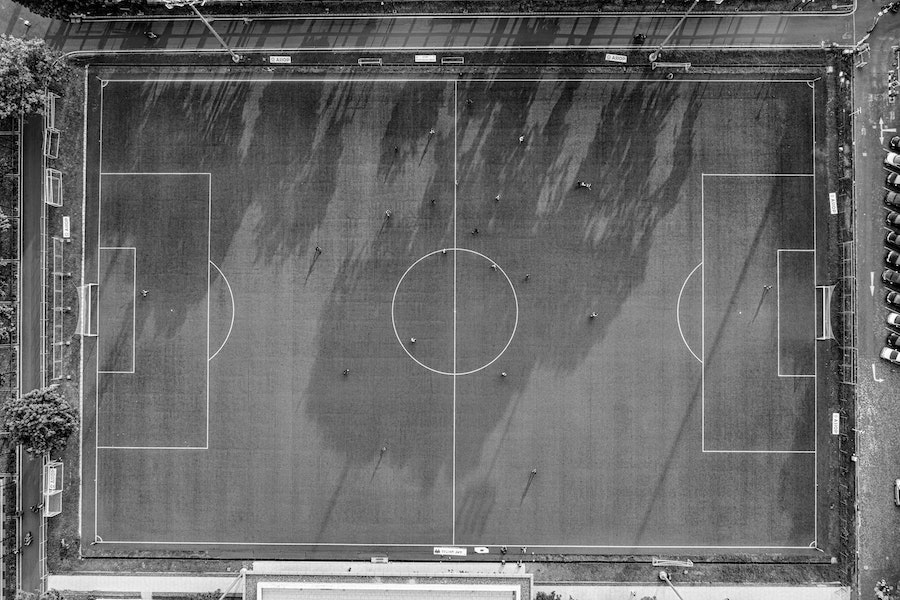This article was originally published in October 2020.
Artificial pitches help small clubs bring in revenue and foster community football. Why must they tear them up to get promoted?
After the recent National League play-offs, Harrogate Town FC have just become the first English club playing on a 3G artificial pitch to be promoted to the top four divisions of English football – the English Football League. This should be happy news for me, an enthusiastic and obstinate drumbeater for 3G pitches. I have been campaigning for years to promote greater understanding of the benefits of today’s top-quality artificial pitches, ever since Maidstone United, a modest professional club of which I am a director, became the first in England to construct a new football stadium with a purpose-built 3G pitch.
On the back of our positive experiences running the business with the benefit of a 3G pitch, we offered to share our knowledge with other clubs and help spread the gospel about the 3G business model. Seven years on, there are growing numbers of clubs at pro and semi-pro level enjoying using 3G pitches. Indeed, I don’t know any that regret it. Well, why should they? 3G pitches are lush and flat so they promote high-quality passing football. Good players thrive. Nothing, however, prevents hardened defenders from going in sliding to recover the ball as they would on a muddy field – except for the fact that skilled attackers will leave them looking stupid lying on the ground.
Clubs with 3G pitches can hire them to raise revenue, nurture a whole range of community teams in-house, operate academies that can use the pitch at off-peak times, and develop wide-ranging affiliations that in turn generate new revenues, including those from increased first-team match attendance, events, room hire, sponsorship and merchandising. Furthermore, clubs suffer no cash flow crises from bad weather postponements, which are a thing of the past on a 3G pitch. And in case you are wondering, 3G pitches are not dangerous to play on like the old 1G ones were in the 1980s. Medical studies have shown that.
Yes, there are players who don’t like them and prefer to play on a pristine grass surface – but then so would I, all other things being equal. But things are not equal. You can’t play anything like 50 hours a week in virtually all weather on a natural surface, unless you are into mud wrestling, that is. Clubs are desperate for sustainable revenues in this terrible crisis year, and when you get below the Championship in English football the quality of natural surfaces is very varied. Some natural pitches are dreadful. Finally, it’s worth mentioning that FIFA and UEFA allow 3G pitches in World Cup and Champions League matches, so for the fourth level of English football to refuse them is patently ridiculous.
FIFA and UEFA allow 3G pitches in World Cup
and Champions League matches, so for the
fourth level of English football to refuse
them is patently ridiculous
So why am I not leaping about with delight to see Harrogate Town showcasing their 3G pitch in the EFL? Because they won’t be! The EFL do not currently allow 3G pitches at any level in their competition and so Harrogate have been forced to rip up their old pitch and are replacing it with a natural surface at a total cost – including the loss of value of their existing pitch – of about £1m. Yes, £1m simply thrown away.
As promotion became a realistic possibility over the past few weeks, Harrogate argued, campaigned, pressed their case and pleaded with the FA and the EFL but, as is so often the case with sensible arguments in English football, it was all to no avail. The only option left to the club owner (which he did not take up) was to chain himself to the gates of EFL House in protest at the utter stupidity of the current rules, which oblige successful community clubs to pay for their success by being forced to rip up and destroy their Champions League-quality pitches, those same pitches that permit clubs to be financially sustainable in an era of football club bankruptcies and meltdowns. It is so insane that, had I been asked, I might have done the chaining to the gates of EFL House myself.
However, Harrogate FC are different from most non-league clubs, who struggle desperately to balance the books each season. Because they are financed by a wealthy local owner, Irving Weaver, they are one of the few 3G clubs that could afford to follow the rules and go quietly. In so doing they at least temporarily gave up the fight to get EFL to accept 3G pitches, never mind accepting the destruction of their community football hub. With their previous top-quality 3G pitch, the club’s youth teams, women’s teams, disability football teams and local amateur teams all got to enjoy the thrill of training and playing at the stadium. With the 3G pitch gone, whatever the planned alternative is, it won’t be the same.
Additionally, the pressure has now been lifted from the EFL to accept change. Why should we accept 3G pitches, they will argue? Look, National League clubs are happy to replace them with lovely new natural surfaces…
Now, with covid wreaking havoc – not to mention the other troubles the EFL has been facing for a while – the time was right for the EFL to take a commonsense lead and offer its smaller clubs the option of using 3G pitches to boost their annual revenues by around £400,000 to £500,000 and reinforce relationships with their fans and local communities. Our group of football clubs in favour of 3G pitches, 3G4US, has been lobbying and arguing for months with the EFL but all our petitions have so far fallen upon deaf ears.
In fairness to the good people at Harrogate FC, they have now pledged to continue campaigning to change the EFL ban on 3G pitches from within. That is a real hope and we will continue to work together to that end. Nevertheless, their promotion should today be the story of a club leading the way to a brighter future for clubs and their fans on 3G pitches in League 2, the fourth tier of English football. Instead it is another reminder of how English football is still so badly mismanaged.








